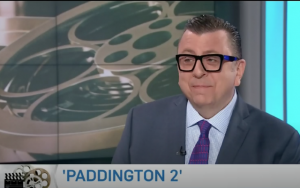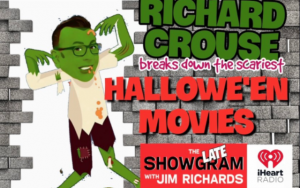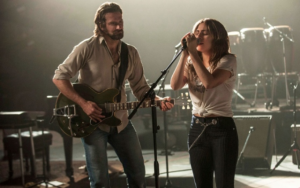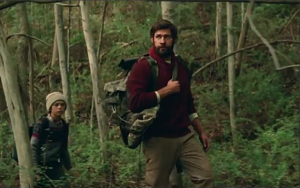 Richard has the top movies of 2018 starting with ‘Paddington 2’, horror film ‘A Quiet Place’ and his pick for the summer hit.
Richard has the top movies of 2018 starting with ‘Paddington 2’, horror film ‘A Quiet Place’ and his pick for the summer hit.
Watch the whole thing HERE!
Here’s the full list:
A QUIET PLACE: 4 STARS
The silence of the first half of “A Quiet Place” is deafening. There is no spoken dialogue for forty minutes, just dead air. In the way that many filmmakers use bombast to grab your attention Krasinski uses the absence of sound to focus the audience on the situation. Very little information is passed along. We don’t know where the aliens came from, why they’re terrorizing earth or how many there are. Ditto the Abbotts. We know nothing about them. The connection the family feels is transmitted through looks and actions, not words. This isn’t a story where character development is important, it’s a tale of survival pure and simple.
Tension grows in the first, artier half and pays dividends in the second more genre-based half. Set up out of the way Krasinski raises the stakes, putting the family directly in the way of the creatures. Like all good genre movies as the story escalates it becomes not simply about predatory monsters, all teeth and giant ears, but about a universal truth. In this case it is about a parent’s primal need to protect their kids at any cost. Krasinski nails this, providing both the b-movie thrills and chills necessary to the genre and a deep undercurrent of humanity.
He’s aided by the actors. Blunt is all poignancy and strength. Krasinski brings stoicism while the kids make us care about the family.
“A Quiet Place” is a nervy little film. Other filmmakers might have tried to find a way to wedge in more dialogue or spell things out more clearly but the beauty of Krasinski’s approach is its simplicity. Uncluttered and low key, it’s a unique and unsettling horror film.
BLACK PANTHER: 4 ½ STARS
Chadwick Boseman has made a career of playing iconic characters on screen. As sports legend Jackie Robinson in “42” or James Brown, the Godfather of Soul, in “Get on Up,” or Thurgood Marshall, the first African-American Supreme Court Justice in “Marshall,”: he has breathed new life into characters we thought we already knew. Here he takes a well-known comic book character, the first black standalone superhero in the Marvel Universe, and delivers a performance ripe with subtext. His Black Panther is not only capable of fighting the bad guys but is also a vessel for the film’s study of the importance of legacy and identity.
“Black Panther” pushes the Marvel Universe past the typical Avengers style bombast fests like “Age of Ultron.” This is a breath of fresh air, a warm breeze along the lines of “Ant-Man” or “Doctor Strange,” films that transcend the superhero genre, pushing the form into new, unexplored territory. It may be a tad too long and slightly uneven in it’s first hour but with its strong female characters—who work together rather than as opponents—an Afrocentric story and social commentary it feels like the perfect movie for right now.
DEADPOOL 2: 4 STARS
Irreverence thy name is Deadpool. The Ryan Reynolds’ franchise is related to the Marvel and X-Men Universes but feels like he’s from a planet all his own. He talks directly to the audience, compares his box office to other movies and even comments on the action around him. “There’s a big CGI fight coming up,” he says, saving me the trouble of mentioning my least favourite aspect of the superhero genre. The jokes may not feel quite as fresh as they did the first time around but Reynolds, face covered under a mask 95% of the time, delivers the lines with pitch perfect delivery. Mixing one-liners with pop culture references—everything from “Yentl” to 007 to “Frozen”—he provides a running commentary that would be exhausting if not so gleefully delivered. Not all the jokes land and the Jared Kushner gag may age badly but Reynolds gets an A for effort.
“Deadpool 2” has all the elements of a summer superhero blockbuster. There’s action—directed by David Leitch, “one of the guys who killed the dog in John Wick.”—a conflicted villain—a territory Josh Brolin seems to be cornering—and some heavy franchise building. It also has something new, at least for the “Deadpool” movies and that’s humanity. It is the opposite of genteel but it gives the loudmouth lead an opportunity to grow as a character. It’s tough to follow up a movie as audacious as “Deadpool.” Fans have expectations and for the most part they are met. The jokes and the set pieces are bigger and badder but it’s the mushy stuff that prevents “Deadpool 2” from slipping solely into freak show mode. Add to that a credit scene (midway, not post credits) worth the price of admission and you’re left with a movie that works both as a superhero flick and as a twisted family drama.
FILM STARS DON’T DIE IN LIVERPOOL: 4 STARS
By the time actress Gloria Grahame passed away in 1981 at age 57 she was largely forgotten. A new film, “Film Stars Don’t Die in Liverpool,” aims to remind of us of the Oscar winner’s—she won the Best Supporting Actress award in 1952 for The Bad and the Beautiful—life, legacy and love.
Director Paul McGuigan uses some slick camera tricks to jump around in time from the first blush of their relationship to the end and every point in between. Doors open in the present to reveal a scene in the past. It’s showy but dreamy, as though we are hopscotching through Peter’s memory.
Bell is a sweet, sensitive and thoughtful boy-toy who sparks with Bening. He’s very good but this is Bening’s movie. Her Grahame is a wonder, effervescently flirty one second, frail the next. She is the keeper of a heartbreaking secret agenda and a vain woman facing the abyss. It’s remarkable stuff that sits comfortably alongside her stellar recent work in “The Face of Love,” “20th Century Woman” and “Rules Don’t Apply.”
“Film Stars Don’t Die in Liverpool” is a three Kleenex film that will make you want to go back and check out Grahame’s real-life movies. If you haven’t already, check her out as the temptress with an eye for James Stewart in “It’s a Wonderful Life” or as Ado Annie in Oklahoma! She was a great talent and Bening does her justice.
FIRST REFORMED: 4 STARS
Questions are asked; answers are left in the ether. It’s a portrait of a man in progress, trying to figure out his place in the world, if there will be a world to be part of. Hawke is subdued, handing in an internal performance that creates tension as Toller waits for God to tell him what to do. It is powerful work complimented by strong performances from Seyfried and Cedric the Entertainer as the condescending mega-church preacher Pastor Jeffers.
Schrader makes some bold choices here—the film is unrelentingly sombre—but most notably with the sudden and ambiguous ending. Toller looks to be finally taking control of his life, although the form of his redemption is left open to interpretation. This is Schrader’s ode to Andrei Tarkovsky and Ingmar Bergman, contemplative filmmakers of the past who essayed questions of theology and spiritual growth without judging their characters. Uncluttered and edited with laser like attention to detail, “First Reformed” is a thought-provoking movie that bears repeated viewing.
ISLE OF DOGS: 4 ½ STARS
“Isle of Dogs” is a fairy tale with a bite. Anderson, one of the most distinctive directors working today (or any day for that matter), brings a child-like wonder and unfettered imagination to bring this boy-and-his-dog story to vivid life. Gorgeous, soulful stop motion animation and Anderson’s trademarked banter combined with a timely story of deportation and exile makes for an unforgettable film.
The usual complaints about Anderson’s work, that it’s too detailed, too eccentric, will be levelled at this movie but I’d argue it is his obsessiveness that brings the creative magic. Subplots and flashbacks take the viewer on a wild journey but Anderson’s attention to every element, visual and narrative, guarantees the rambunctious story never loses itself in its own elaborate style.
There jokes throughout—even the title is a playful take on “I love dogs”—but just as important are the messages of tolerance. You will not see another film like “Isle of Dogs” this year. So effortlessly cinematic and inventive, it’s best in show.
PADDINGTON 2: 4 ½ STARS
With his red hat and blue duffle coat, Paddington is almost un-bear-ably cute. Gentle and good-natured, he’s at the very heart of the movie. Instead, it’s a good old-fashioned romp with larger-than-life characters supplied by Hugh Grant, in a fun pantomime performance and Brendan Gleeson as Knuckles McGinty, a hardened criminal whose bluster disguises his warm heart.
Mostly though, it about the bear. With soulful eyes, good manners and large doses of slapstick—he’s a furry little Charlie Chaplin, excelling in physical humour with lots of heart—he’s a joyful presence. Without an ounce of cynicism “Paddington 2” transmits messages of tolerance, friendship and loyalty but never at the expense of the story. Those characteristics are so central to Paddington’s character that the movie positively drips with not only the sticky sweet smell of delicious marmalade (the bear’s favourite snack) but emotional depth as well.
“Paddington 2” isn’t just a kid’s flick, it’s a film for the whole family; it’s one of those rare movies for children that doesn’t just feel like an excuse to sell toys. #paddingtonpower
THE PARTY: 4 STARS
Director Sally Potter wastes no time in presenting her sophisticated but sour soiree. The verbal—and text—fireworks begin almost immediately. Sparkling dialogue drips from the mouths of these actors like liquid gold. When Jinny announces she’s having another baby, Martha says, “Triplets. People. Small people.” It doesn’t sound like much on paper, but the magic is in the delivery. The best lines are reserved for Clarkson, whose blunt, plainspoken words add fuel to the already hot state of affairs.
“Although it may have a deleterious effect on your career I think you could consider murder,” she purrs at one point.
Canapés smoulder, truths are revealed—there will be no spoilers here—and lives are shattered, all in just 71 minutes. “The Party” is a delightfully nasty piece of work, artfully realized by Potter and delivered with just the right amount of venom by a dedicated cast.
THE SEAGULL: 4 STARS
Director Michael Mayer avoids the stodginess of previous film adaptations, casting actors with the chops to embrace Chekhov’s dialogue but bring it to life, mining the pathos and the often-neglected humour.
Bening is wonderfully cast, bringing a haughtiness to Irina that covers a wide vulnerable streak. As Nina, the star struck actress, Ronan is nails the transformation from wide-eyed ingénue to world-weary with ease but it is two supporting performances that threaten to steal the show from the leads.
As Irina’s brother Pjotr Sorin, Brian Dennehy wraps his tongue around Chekhov’s words in a way that sounds like music to the ears.
I suspect that it will be Elisabeth Moss’s Masha people will remember after the final credits roll. Melodramatic and miserable, Masha is tormented by her unrequited feelings for Konstantin and unfulfilled dreams. Moss plays her like a nineteenth century goth, draped in black. “I’m in mourning for my life,” she says. It is tremendous stuff, buoyed by Masha’s use of humour as a protective sword for her exposed feelings. “A lot of women drink,” she says, “just not as openly as I do.”
“The Seagull” doesn’t feel like a filmed version of a stage play. Mayer keeps the camera in constant motion, bringing an up-close-and-personal feel to the story of entangled attractions.
UNSANE: 4 STARS
“Unsane” is a nightmare that stems from not reading the fine print. “They got meds,” says fellow inmate Nate (a terrific Jay Pharoah). “You got insurance. You talk, they find a way to get you committed and you stay as long as your insurance will pay. When they stop paying, you’re cured!” Sawyer’s situation is a political comment on insurance scams and locking up people for profit. It’s a #MeToo thriller—no one believes her stories of stalking—but really, at its heart, “Unsane” is a Gothic b-movie that owes a debt to “The Snakepit” and “Shock Corridor” with some “Gaslight” thrown in for good measure. It’s an examination of women’s voices not being heard of a crumbling medical infrastructure but mostly it’s about Sawyer’s world falling apart and her frustration at not being able to do diddly-squat to put it back together.
Foy is in almost every frame, bringing a frail yet steely presence to the role. She is more than a damsel in distress. By turns charming, cunning, ruthless and jittery, she’s a character designed to keep us guessing. Does she belong in the facility or not? “The Queen” star navigates Sawyer’s personality shifts, zigging and zagging, keeping the audience tantalizingly in the dark as to the truth of her mental state.
“Unsane” has a few clunky moments that detract from the overall feeling of paranoia Soderbergh builds throughout. Beautifully composed and edited “Unsane” still looks like it was shot on an iPhone. Often blown out or bathed in inky blacks it’s an aesthetic we’ve become used to from Instagram and social media videos and it brings and naturalism to the surreal story.
“Unsane” may be low tech but it’s not amateurish. Soderberg expertly builds tension to the point where Sawyer’s frustration is palpable.
YOU WERE NEVER REALLY HERE: 4 STARS
There is violence in “You Were Never Really Here” but don’t expect a Liam Neeson style action flick. First of all Joe’s special set of skills mainly include surveillance and ball peen hammer assault. Secondly Joe doesn’t have any catchphrases. He’s a secretive man of action, plagued by PTSD and driven by a sense of righteous justice. Think Travis Bickle, not former Green Beret and CIA operative Bryan Mills.
Phoenix delivers a deceptively simple performance. A man of few words Joe expresses himself in other ways and Phoneix finds way to do much while doing very little. The pain in his eyes, amplified by random flashbacks to his troubled youth, reveals both his personal torture and why he works exclusively with mistreated children. More importantly are the traces of humanity that slip through Joe’s blank façade. The way he dotes on his mother or holds a dying man’s hand, singing along with a syrupy pop song, as life slips away. In another scene he instructs his pre-teen rescue to close her eyes, trying to protect what little innocence she has left, before he bludgeons one of her captors to death. It’s in these moments that Joe becomes a fully rounded character and not simply a killing machine.
Scottish director Lynne Ramsay never gives away the game, doling out the details only as necessary. The flashbacks are jagged, poking into the story like a shard of glass slashing through silk. Those elements, bolstered by an anxiety inducing score—loud, abrasive yet beautiful—from Radiohead’s Jonny Greenwood, combine to present an intriguing, elliptical portrait of a tortured soul.
 I write about “chicken-soup” movies that’ll cure what ails you for CTVNews.ca!
I write about “chicken-soup” movies that’ll cure what ails you for CTVNews.ca!



